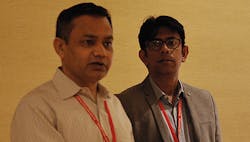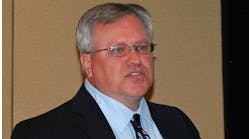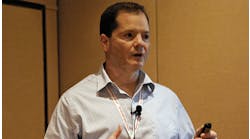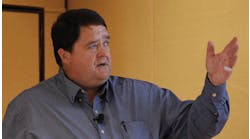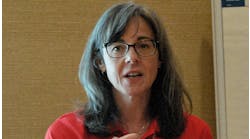Honeywell takes on workforce optimization 'in real life'
“Now people come into the plant ready to start delivering results within weeks. There is no longer a months-long training period.” Pramesh Maheshwari and Manas Dutta (right), discussed how Honeywell’s Workforce Excellence program enables safety, productivity, on-the-job assistance and compliance, resulting in long-term, sustainable business results.
At the start of his presentation on digitalization and workforce development during the Honeywell Users Group (HUG) Americas conference this week in Orlando, Fla., Pramesh Maheshwari noted how refreshing it was to be at an in-person event. In an actual room with actual people discussing actual work.
He used a term borrowed from the Millennial generation to describe this scenario—IRL (In Real Life). That concept, IRL, was a common thread throughout this discussion hosted by Maheshwari, VP/GM of lifecycle support & services for Honeywell Process Solutions, and his colleague Manas Dutta, GM for the organization’s workforce-excellence growth initiative. Industrial enterprises, even as they ramp up automation programs, increasingly require educated, trained, committed, creative professionals to operate those facilities IRL.
Smart factories need smart workers. They’re having a hard time finding them.
A solution to this problem was central to this presentation. Honeywell Workforce Excellence is “an industry-wide, end-to-end, technology-based competency management service program that enables safety, productivity, on-the-job assistance and compliance resulting in long-term sustainable business results.”
That’s how Honeywell describes it. In short, it’s a software-as-a-service initiative to engage and train new workers to fast-track their workplace competency and to promote efficiency that benefits the larger enterprise.
Results are quantifiable, the duo stressed, with Dutta describing this as an “outcome-based program.” Metrics include the recovery time from process upsets or calculable gains in output after implementation of this training regimen. One example they provided is 70% fewer safety incidents among personnel trained in this manner, per a study Honeywell conducted. “We can provide a per-dollar [spend vs. profit] breakdown of how this is effective,” promised Dutta. “It’s important to us to help customers understand that.”
It’s important to customers, too.
One graphic displayed during the presentation summarized the larger missions of the Honeywell Workforce Excellence offering. The pillars are as follows:
- Improve Productivity (Do More with Less): Provide the right tools that help workers perform their tasks efficiently. Make workforces ready to use software and analytics on demand while improving situational awareness.
- Address Workforce Churn: Teach/upskill workers faster and reduce time to competency. Jobs are being transformed by the technologies of the fourth Industrial Revolution. Existing workforces must be reskilled.
- Improve Collaboration: Unite machine-to-machine, human-to-machine and human-to-human collaboration/interaction that turns insights into intelligence and intelligence into action.
- Acknowledge Continuously Evolving Jobs: Due to changing business needs and the technological landscape, organizations’ skill requirements are evolving and emerging. A framework for continuous monitoring of the skills gap and improvement options is the need of the hour.
Those four guidelines are flexible enough to be applied across industries, regardless of enterprise size or vertical, and are able to adapt to the fluid nature of workforce training.
As the presenters noted, the needs for professional learning have changed. How people learn and retain knowledge is in flux. Training no longer takes place in classrooms, but in the digital realm, replicating real working conditions in real workplaces. Sometimes training entails virtual-reality rigs that put a trainee in a digital twin of the environment in which she will work. (Maheshwari noted with a hint of pride how one hyper-realistic virtual reality representation of a towering ledge in the digital twin of a plant gave one trainee a mild bout of vertigo.)
Occasional vertigo aside, the results are impressive…apparent on Day 1 of work, per the presenters. “Now people come into the plant ready to start delivering results within weeks,” the VP said. “There is no longer a months-long training period.”
That’s good for both the employee and the employer—better-trained employees delivering results IRL weeks before they would in previous scenarios. “Our goal is to make workers more effective, efficient, safe, competent and compliant in how they work,” he added.
And why is Honeywell, of all enterprises, offering a training program like this? Its customers, of course. “My job is to resolve customer challenges,” Maheshwari explained. “And the most common challenges presented to us at Honeywell are people challenges. Staffing challenges.”
While this specific Honeywell Workforce Excellence program was launched two years ago, and its release widened just this year, it is born out of a decade-long mission to consider the bigger picture of delivering results to customers. The “future of services” these co-presenters called it. The mindset that a great day for customers is a great day for Honeywell.
“Does industry have enough people to do the work?” asked Maheshwari of himself, before answering his own question. “We don't.”
But we can. We should. And, if programs like this workforce-growth initiative continue to prove successful, we will.
The editors of Control, Control Design and Smart Industry are reporting live from 2022 Honeywell Users Group in Orlando, Florida, to bring you the latest news and insights from the event. When the event comes to a close, the best, most important coverage will be compiled into a report by the editors.
Register now to pre-order the report and be among the first to receive it in your inbox.

